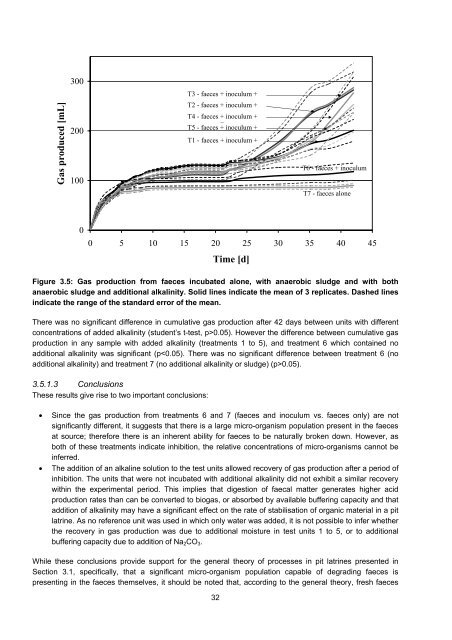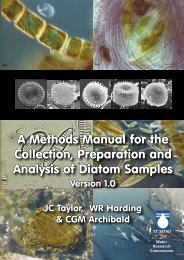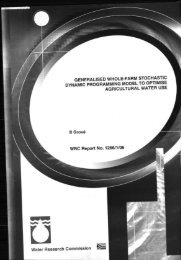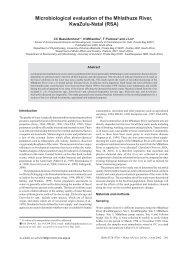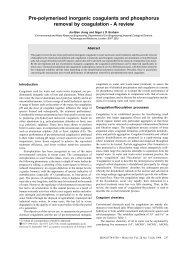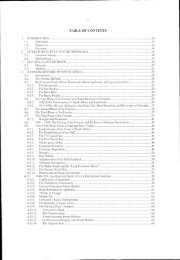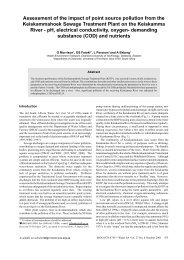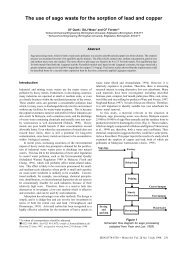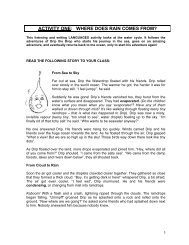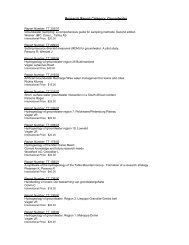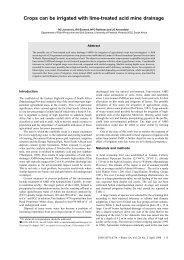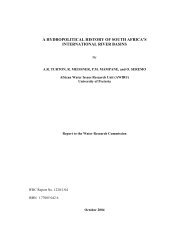and the Efficacy of Pit Latrine Additives - Water Research Commission
and the Efficacy of Pit Latrine Additives - Water Research Commission
and the Efficacy of Pit Latrine Additives - Water Research Commission
- No tags were found...
You also want an ePaper? Increase the reach of your titles
YUMPU automatically turns print PDFs into web optimized ePapers that Google loves.
300<br />
T3 - faeces + inoculum +<br />
Gas produced [mL]<br />
200<br />
100<br />
T2 - faeces + inoculum +<br />
T4 - faeces + inoculum +<br />
lk<br />
T5 - faeces + inoculum +<br />
T1 - faeces + inoculum +<br />
T6 - faeces + inoculum<br />
T7 - faeces alone<br />
0<br />
0 5 10 15 20 25 30 35 40 45<br />
Time [d]<br />
Figure 3.5: Gas production from faeces incubated alone, with anaerobic sludge <strong>and</strong> with both<br />
anaerobic sludge <strong>and</strong> additional alkalinity. Solid lines indicate <strong>the</strong> mean <strong>of</strong> 3 replicates. Dashed lines<br />
indicate <strong>the</strong> range <strong>of</strong> <strong>the</strong> st<strong>and</strong>ard error <strong>of</strong> <strong>the</strong> mean.<br />
There was no significant difference in cumulative gas production after 42 days between units with different<br />
concentrations <strong>of</strong> added alkalinity (student’s t-test, p>0.05). However <strong>the</strong> difference between cumulative gas<br />
production in any sample with added alkalinity (treatments 1 to 5), <strong>and</strong> treatment 6 which contained no<br />
additional alkalinity was significant (p0.05).<br />
3.5.1.3 Conclusions<br />
These results give rise to two important conclusions:<br />
Since <strong>the</strong> gas production from treatments 6 <strong>and</strong> 7 (faeces <strong>and</strong> inoculum vs. faeces only) are not<br />
significantly different, it suggests that <strong>the</strong>re is a large micro-organism population present in <strong>the</strong> faeces<br />
at source; <strong>the</strong>refore <strong>the</strong>re is an inherent ability for faeces to be naturally broken down. However, as<br />
both <strong>of</strong> <strong>the</strong>se treatments indicate inhibition, <strong>the</strong> relative concentrations <strong>of</strong> micro-organisms cannot be<br />
inferred.<br />
The addition <strong>of</strong> an alkaline solution to <strong>the</strong> test units allowed recovery <strong>of</strong> gas production after a period <strong>of</strong><br />
inhibition. The units that were not incubated with additional alkalinity did not exhibit a similar recovery<br />
within <strong>the</strong> experimental period. This implies that digestion <strong>of</strong> faecal matter generates higher acid<br />
production rates than can be converted to biogas, or absorbed by available buffering capacity <strong>and</strong> that<br />
addition <strong>of</strong> alkalinity may have a significant effect on <strong>the</strong> rate <strong>of</strong> stabilisation <strong>of</strong> organic material in a pit<br />
latrine. As no reference unit was used in which only water was added, it is not possible to infer whe<strong>the</strong>r<br />
<strong>the</strong> recovery in gas production was due to additional moisture in test units 1 to 5, or to additional<br />
buffering capacity due to addition <strong>of</strong> Na 2 CO 3 .<br />
While <strong>the</strong>se conclusions provide support for <strong>the</strong> general <strong>the</strong>ory <strong>of</strong> processes in pit latrines presented in<br />
Section 3.1, specifically, that a significant micro-organism population capable <strong>of</strong> degrading faeces is<br />
presenting in <strong>the</strong> faeces <strong>the</strong>mselves, it should be noted that, according to <strong>the</strong> general <strong>the</strong>ory, fresh faeces<br />
32


